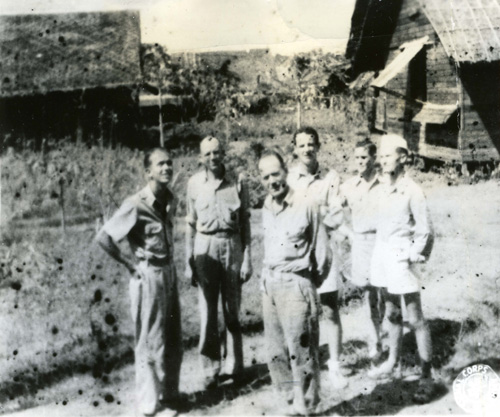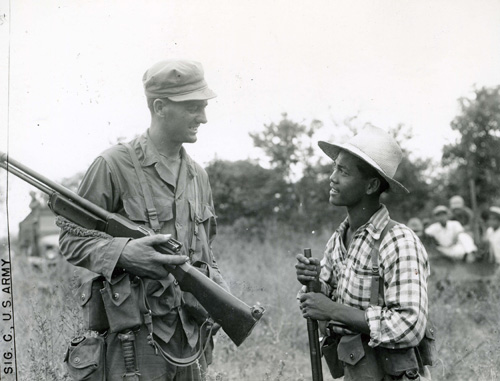US Army Rangers and Filipinos free hundreds of Allied captives at the Japanese Cabanatuan prison camp on Luzon in early 1945.
Carts drawn by water buffalo hauling food into the Cabanatuan POW camp on Luzon in the Philippines in 1943. The Japanese allowed supplies to be brought in until they found money and messages hidden in a delivery in May 1944. They responded by beating prisoners and forbidding further deliveries. Conditions deteriorated. (National Archives)
A member of the 6th US Army Special Reconnaissance Force holding a Browning Automatic Rifle talks with with a Filipino guerrilla. With the help of the Filipinos, the Americans launched a daring and unexpected raid on the Cabanatuan camp in early 1945. (National Archives)

The 121 US Army Rangers and 165 Filipino guerillas of the raiding force commanded by Captain Robert Prince cross a creek along the way to the camp to rescue the hundreds of Allied prisoners being held there. Most of the POWs were Americans. (National Archives)

The raiders slog along paths cut through the fields of tall grass that covered much of this part of Luzon. (National Archives)

Unlike this growth, the grass closer to the prison camp was kept cut short, which would make surprising the Japanese guards tricky. (National Archives)

One of the Filipino guerilla commanders had an idea for keeping the Japanese guards from noticing the raiders slipping through the short grass near the camp: put on an air show. A P-61 Black Widow night fighter like these distracted guards as raiders crept up to attack. (National Archives)

Some of the reasons for the Cabanatuan raid: a handful of the 500 POWs held by the Japanese at the camp. Rescuers reacted with horror at the emaciated condition of even the healthiest prisoners. These men, despite their emaciated condition, were in good shape compared to many of the others. (National Archives)

As soon as possible after the raid, rangers and prisoners were treated for wounds and other medical problems. (National Archives)

Prisoners and wounded too ill or weak to walk were transported in carts pulled by water buffalo. (National Archives)

Back to Bataan starred John Wayne, who had sparked controversy by not enlisting in the military and later said he felt guilty for the rest of his life. The 1945 film, a mix of fact and fiction, begins with the raid on the Cabanatuan camp and then flashes back to 1942 and the Battle of Bataan, where many of the POWs had been taken captive. (National Archives)




FOLLOW US »
